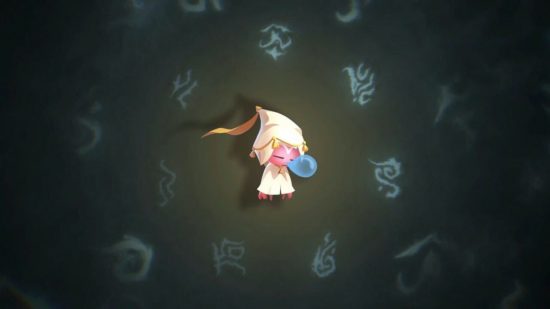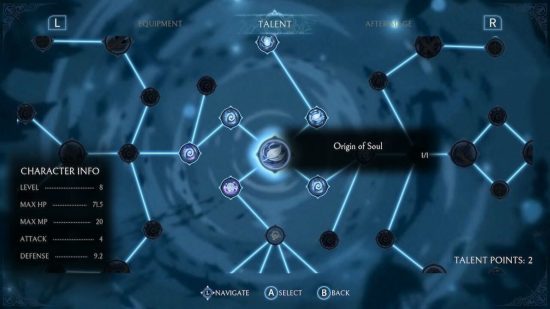Our Verdict
A gorgeous fantasy Metroidvania with a lot of promise, let down by its repetitive combat and bewildering story
The Metroidvania genre is one that I’ve looked at from afar for a while but never been brave enough to dip my toe into. They have dedicated fanbases, complex combat, and intriguing storylines, and many of them see success on the Nintendo Switch as they make for great portable games. When I saw the trailer for Afterimage, I decided that this game would be my gateway into the genre so I could see what all the fuss is about.
Afterimage is a gorgeous hand-drawn 2D Metroidvania platformer set in the ruins of the fantasy land of Engardin. The anime-inspired character designs and vibrant colour palette attracted me to the game in the first place, and they certainly don’t disappoint. You play as Renee, an amnesiac girl forced to leave her old life behind with only her little floating friend Ifree for company.
Aesthetically, the area design in Afterimage is phenomenal. Each section of Engardin feels unique and distinct from the last without becoming completely disconnected. The use of colour and lighting is perfect, including a particularly stunning section early on in the game that is reminiscent of Limbo. Even the death screen is beautiful, and as you’ll soon discover, I’ve spent a lot of time looking at it.
The game’s soundtrack also helps to create an ethereal, fantastical atmosphere perfect for this kind of story. However, the story itself completely lost me. Usually I’m all for diving into a new world head first and figuring things out bit by bit, but the dialogue and item descriptions in Afterimage use so much Engardin-specific language that I just can’t follow what’s going on.
Aurogon Shanghai is clearly going for a Souls-like approach to storytelling if you look solely at the flavour text on items you come across. The descriptions are so full of lore that initially intrigued me, but I now feel indifferent towards because I’ve spent so much time in this world already and am still no closer to understanding it. On top of this, the team don’t fully commit to the item-based storytelling method and intersplice the action with static visual novel-style dialogue scenes that reveal even less than the item descriptions.
In games like this, I often spend a lot of time in the quest menu to remind myself of where I’m going and what I’m doing. Afterimage does have a quest menu but it doesn’t provide any useful information for figuring out my next steps. The game writes quests like Renee’s diary entries and they have yet to enlighten me on my apparent goal.
This might be a bit nitpicky, but personally, I think Ifree’s character is essentially pointless. Don’t get me wrong, I love a floating sidekick (I play Genshin after all) but I have no idea who Ifree is to Renee, why they’re with her, and what they can do. So far, they’ve shot one fireball at the first boss I encountered and then done nothing else. I just want to know who this little guy is!
Afterimage’s exploration is a mixed bag. I really enjoy looking for hidden walls and passageways, especially when they unlock a shortcut for later. It makes me feel smart and it feels rewarding. But conversely, there are some surfaces that feel like they should be breakable or moveable that I still can’t seem to get past. Some floors, for example, seem like they might require a ‘ground-pound’ style ability to smash, but I can’t be sure. A tooltip saying something like ‘I need something heavy to break this’ like in Pokémon would do the trick, just to assure me that I’m not going insane.
The combat is… fine. You get a main weapon, a secondary weapon, and a magic slot, and there’s a decent variety of weapon types. I’ve found myself favouring the scythe as my main weapon purely for reach, as getting too close to the enemies even if they aren’t attacking you leads to damage. When you’re grinding experience for levels, the combat gets very monotonous very quickly. The attacks are basic and you can’t chain combos between your weapons and magic to switch things up. Then all of a sudden, you encounter a boss that kills you in one hit out of nowhere.
I’ll be honest, one of the boss fights in Afterimage has nearly driven me to tears of frustration several times now because I just can’t clear it. As I said earlier, this is my first foray into the genre, and I know that it’s meant to be difficult, but this just seems unfair, especially as beating this boss is the only means of progression. A lot of the appeal of Metroidvanias is being able to backtrack and try something else when you’re stuck, but there are even limitations to backtracking at a certain point due to a massive, unscalable cliff on the map.
I’ve also had a lot of issues with the talent menu, both in terms of upgrading my build to suit my playstyle and just navigating it in general. The design is beyond confusing and navigating it with the Switch joystick is near impossible. This game’s marketing boasts various unique builds and playstyles, but I’ve found that the arbitrary level caps applied to upgrading the skill tree just lead me to unlock whatever I’m allowed to unlock. I wanted to add more points into health and defence to balance out my lack of combat skill, but I simply wasn’t allowed.
This brings me to accessibility. I make an effort to talk about it in all of my reviews because it means a lot to me and also directly affects the way I play games. All the dialogue in Afterimage is fully voiced and shown in subtitles and they’re a decent size, but there aren’t any settings to make them bigger or higher contrast. There’s a whole menu for button remapping which is wonderful as it’s quite rare to see this in Switch games.
My main accessibility gripe is once again the difficulty of progression. There are no difficulty settings, many of the tooltips telling you how a new mechanic works come far too late (often just before I die), and the game does nothing to help you if you’ve died several times in the same spot. I can see that this is another Souls-inspired mechanic, but it just feels terrible. If Afterimage instead took inspiration from Hades and added an optional mechanic that buffs your stats every time you die, I think I would have a much better time.
Overall, I think there are definitely some people out there who will love this game, especially if they enjoy a grinding-heavy challenge. The style is fantastic and I’m intrigued by the setting, but the gameplay is so punishing at times that I wanted to throw my controller out the window, and extremely dull at others. I’m sad that this was my first attempt at a Metroidvania title, but I do think fans of the genre will get more out of this than I did.
If you’re looking for some alternative portable sidescrollers, check out our list of the best Switch Metroidvanias. Or if you love a challenge, we have a list of the best hard games on Switch and mobile too.




